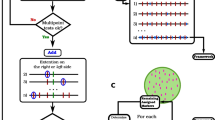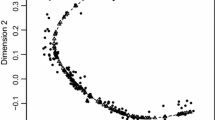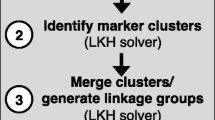Abstract
The paper is devoted to the problem of multipoint gene ordering with a particular focus on "dominance" complication that acts differently in conditions of coupling-phase and repulsion-phase markers. To solve the problem we split the dataset into two complementary subsets each containing shared codominant markers and dominant markers in the coupling-phase only. Multilocus ordering in the proposed algorithm is based on pairwise recombination frequencies and using the well-known travelling salesman problem (TSP) formalization. To obtain accurate results, we developed a multiphase algorithm that includes synchronized-marker ordering of two subsets assisted by re-sampling-based map verification, combining the resulting maps into an integrated map followed by verification of the integrated map. A new synchronized Evolution-Strategy discrete optimization algorithm was developed here for the proposed multilocus ordering approach in which common codominant markers facilitate stabilization of the marker order of the two complementary maps. High performance of the employed algorithm allows systematic treatment for the problem of verification of the obtained multilocus orders, based on computing-intensive bootstrap and jackknife technologies for detection and removing unreliable marker scores. The efficiency of the proposed algorithm was demonstrated on simulated and real data.





Similar content being viewed by others
References
Bailey NTJ (1961) Introduction to mathematical theory of genetic linkage. Calendon Press, Oxford
Bourque G, Pevzner PA (2002) Genome-scale evolution: reconstructing gene orders in the ancestral species. Genome Res 12:26–36
Boyko E, Kalendar R, Korzun V, Fellers J, Korol AB, Schulman AH, Gill BS (2002) A high-density cytogenetic map of the Aegilops tauschii genome incorporating retrotransposons and defense-related genes: insights into cereal chromosome structure and function. Plant Mol Biol 48:767–790
Buetow KN, Chakravarti A (1987) Multipoint gene mapping using seriation. Am J Hum Genet 41:189–201
Cone KC, McMullen MD, Bi IV, Davis GL, Yim YS, Gardiner JM, Polacco ML, Sanchez-Villeda H, Fang Z, Schroeder SG, Havermann SA, Bowers JE, Paterson AH, Soderlund CA, Engler FW, Wing RA, Coe EH Jr (2002) Genetic, physical, and informatics resources for maize: on the road to an integrated map. Plant Physiol 130:1598-1605
Curtis D, Gurling H (1993) A procedure for combining two-point lod scores into a summary multipoint map. Hum Hered 43:173–185
Efron B (1979) Bootstrap method: another look at the jackknife. Ann Stat 7:1–26
Ellis T (1997) Neighbour mapping as a method for ordering genetic markers. Genet Res 69:35–43
Esch E, Weber WE (2002) Investigation of crossover interference in barley (Hordeum vulgare L.) using the coefficient of coincidence. Theor Appl Genet 104:786–796
Falk CT (1992) Preliminary ordering of multiple linked loci using pairwise linkage data. Genet Epidemiology 9:367–375
Fogel D (1992) Evolving artificial intelligence. PhD thesis, University of California, San-Diego
Hall D, Bhandarkar SH, Wang J (2001) ODS2: a multiplatform software application for creating integrated physical and genetic maps. Genetics 157:1045–1056
Harushima Y, Yano M, Shomura A, Sato M, Shimano T, Kuboki Y, Yamamoto T, Lin SY, Antonio BA, Parco A, Kajiya H, Huang N, Yamamoto K, Nagamura Y, Kurata N, Khush GS, Sasaki T (1998) A high-density rice genetic linkage map with 2,275 markers using a single F2 population. Genetics 148:479–494
Holland J (1975) Adaptation in natural and artificial systems. MIT PRESS, Cambridge, USA
Homberger J, Gehring H (1999) Two evolutionary metaheuristics for a vehicle routing problem with time windows. INFOR 37:297–318
Jansen J, de Jong AC, van Ooijen JW (2001) Constructing dense genetic linkage maps. Theor Appl Genet 102:1113–1122
Kirkpatrick S, Gellatt CD, Vecchi MP (1983) Optimization by simulated annealing. Science 220:671–680
Klein PE, Klein RR, Cartinhour SW, Ulanch PE, Dong J, Obert JA, Morishige DT, Schlueter SD, Childs KL, Ale M, Mullet JE (2000) A high-throughput AFLP-based method for constructing integrated genetic and physical maps: progress toward a sorghum genome map. Genome Res 10:789–807
Knapp SJ, Holloway JL, Bridges WC, Liu BH (1995) Mapping dominant markers using F2 mating. Theor Appl Genet 91:74–81
Lathrop GM, Llouel JM (1984) Easy calculation of lod scores and genetic risks on small computers. Am J Hum Genet 36:469–465
Lathrop GM, Llouel JM, Julier C, Ott J (1985) Multilocus linkage analysis in humans: detection of linkage and estimation of recombination. Am J Hum Genet 37:482–498
Lander ES, Green P (1987) Construction of multilocus linkage maps in human. Proc Natl Acad Sci USA 84:2363–2367
Lin S, Kernighan B (1973) An effective heuristic algorithm for the TSP. Operation Res 21:498–516
Liu BH (1998) Statistical genomics: linkage, mapping, and QTL analysis. CRC Press, New York
Menz MA, Klein RR, Mullet JE, Obert JA, Unruh NC, Klein PE (2002) A high-density genetic map of Sorghum bicolor (L.) Moench based on 2,926 AFLP, RFLP and SSR markers. Plant Mol Biol 48:483–499
Mester D (1999) The parallel algorithm for vehicle routing problem with time window restrictions. Scientific report, Minerva Optimization Center, Technion, Haifa, Israel
Mester D (2003) Evolutionary strategies algorithm for a large-scale vehicle routing problem with capacitate and time-windows restrictions. J Heuristics (revised)
Mester D, Ronin Y, Minkov D, Nevo E, Korol A (2003) Constructing large scale genetic maps using evolutionary strategy algorithm. Genetics (revised)
Muhlenbein H, Gorges-Scheuter MO, Kramer O (1998) Evolution algorithm in combinatorial optimization. Parallel Computing 7:65–85
Newell RW, Mott R, Beck S, Lehrach H (1995) Construction of genetic maps using distance geometry. Genomics 30:59–70
Nissen V (1994) Evolutionare algorithmen. Deutscher Universitats-Verlag, Wiesbaden
Olson JM, Boehnke M (1990) Monte Carlo comparison of preliminary methods of ordering multiple genetic loci. Am J Hum Genet 47:470–482
Or I (1976) Traveling salesman – type combinatorial problems and their relations to the logistics of regional blood banking. PhD thesis, Dept Industrial Engendering and Management Science, Northwestern University
Osman I (1993) Metastrategy simulated annealing and Tabu Search algorithm for VRP. Ann Operation Res 41:421–451
Parsons YM, Shaw KL (2002) Mapping unexplored genomes. A genetic linkage map of the Hawaiian cricket laupala. Genetics 162:1275–1282
Peng J, Korol A, Fahima T, Roder M, Ronin Y, Li Y, Nevo E (2000) Molecular genetic maps in wild emmer wheat, Triticum dicoccoides: genome-wide coverage, massive negative interference, and putative quasi-linkage. Genome Res 10:1509–1531
Peng J, Ronin Y, Fahima T, Röder MS, Li Y, Nevo E, Korol A (2003) Domestication QTLs in Triticum dicoccoides, the progenitor of wheat. Proc Natl Acad Sci USA 100:2489–2494
Pérez-Enciso M, Roussot O (2002) A method for computing identity by descent probabilities and quantitative trait loci mapping with dominant (AFLP) markers. Genetical Res 79:247–258
Press WT, Hannery BP, Teucolsky SA, Veterling WT (1986) Numerical recipes: the art of scientific computing. Cambridge University Press, London
Rechenberg I (1973) Evolutionstrategie. Fromman-Holzboog, Stutgart
Sall T, Nilsson NO (1994) The robustness of recombination frequency estimates in intercrosses with dominant markers. Genetics 137:589–596
Schwefel H-P (1977) Numeriche Optimierung von Computer-Modelen Mittels der Evolutions-strategie. Birkauser, Basel
Schwefel H-P (1987) Collective phenomena in evolutionary systems. Interne Berichte und Skripten, Fachbereich Informatic, University Dortmund
Schinex T, Gaspin C (1997) Carthagene: constructing and joining maximum-likelihood genetic maps. ISMB 5:258–267
Stam P (1993) Construction of integrated genetic linkage maps by means of a new computer package: JoinMap. Plant J 3:739–744
Thompson EA (1984) Information gain in joint linkage analysis. IMA J Math Appl Med Biol 1:31–49
VanOoijen JW (2002) JoinMap 3.0: advanced computer software for the calculation of genetic linkage maps in experimental populations. j.w.vanooijen@plant.wag-ur.nl
Wang Y, Prade R, Griffith J, Timberlake W, Arnold J (1994) ODS_BOOTSTRAP: assessing the statistical reliability of physical maps by bootstrap re-sampling. CABIOS 10:625–634
Weeks D, Lange K (1987) Preliminary ranking procedures for multilocus ordering. Genomics 1:236–242
Wilson S (1988) A major simplification in the preliminary ordering of linked loci. Genet Epidemiology 5:75–80
Whitaker D, Williams ER (2001) OutMap version 1.0. http://www.ffp.csiro.au/tigr/software/outmap/outmap.htm
Yang YP, Womack JE (1998) Parallel radiation hybrid mapping: a powerful tool for high-resolution genomic comparison. Genome Res 8:731–736
Acknowledgements
This study was supported by the Israeli Ministry of Absorption, the United States-Israel Binational Science Foundation (grant 4556), the German-Israeli Cooperation Project (DIP project funded by the BMBF and supported by the BMBFs International Bureau at the DLR), and the Ancell-Teicher Research Foundation for Molecular Genetics and Evolution. We thank the JoinMap software developers for the possibility to use the package for comparative testing with our new algorithm. The useful comments and suggestions of anonymous referees and J. Snape are acknowledged with thanks.
Author information
Authors and Affiliations
Corresponding author
Additional information
Communicated by J.W. Snape
Rights and permissions
About this article
Cite this article
Mester, D.I., Ronin, Y.I., Hu, Y. et al. Efficient multipoint mapping: making use of dominant repulsion-phase markers. Theor Appl Genet 107, 1102–1112 (2003). https://doi.org/10.1007/s00122-003-1305-1
Received:
Accepted:
Published:
Issue Date:
DOI: https://doi.org/10.1007/s00122-003-1305-1




